The traditional family, Oxynotidae,
includes only one genus and 6 species. In the large reptile tree (LRT, 1936+ taxa, subset Figs. 3,4) Oxynotus (Fig. 1) nests basal to two LRT taxa, Isistius, the cookiecutter shark, and Dalatias, the kitefin shark, both with smaller fins. So… by the rules these two must also be members of the Oxynotidae. Shark experts (Kriwet and Klug 2009) don’t see it that way. More taxonomic issues below.
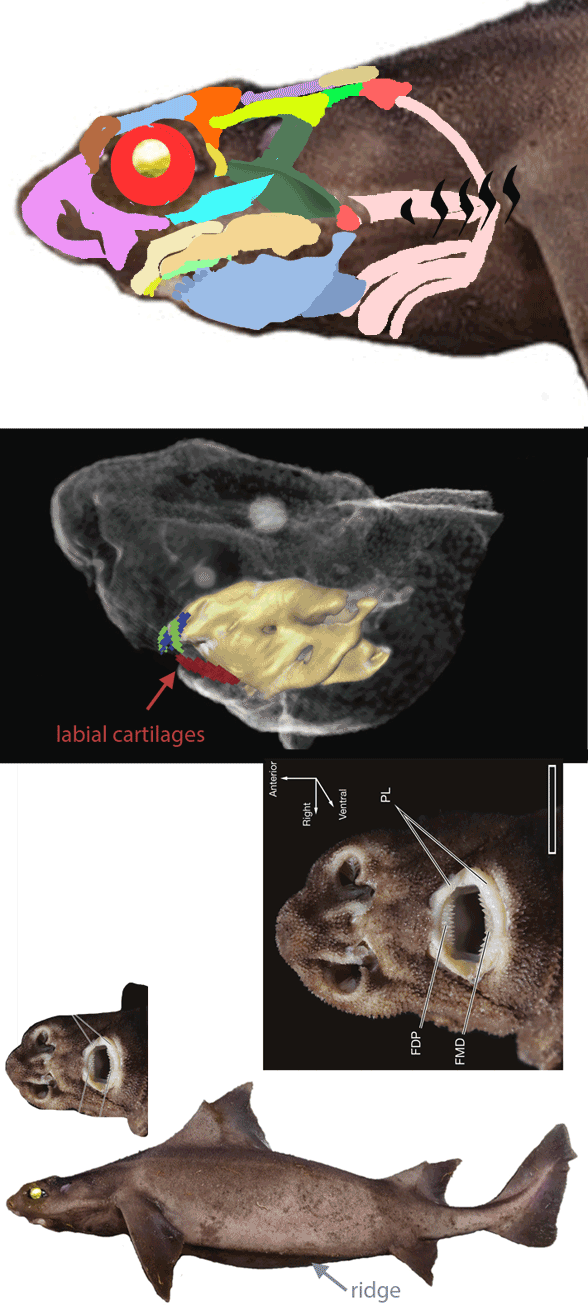
Oxynotus centrina
(Linneaus 1758; up to 1.5m; Fig. 1) is the extant angular roughshark. Ridges appear over the eyes and between the pectoral and pelvic fins. The anal fin is absent, as in other clade members. A dorsal spine is present on both dorsals, but not at the leading edge. These chimaera-like sharks feed on small bottom-dwelling prey, like worms, crustaceans and molluscs. The ventral nares are enormous.
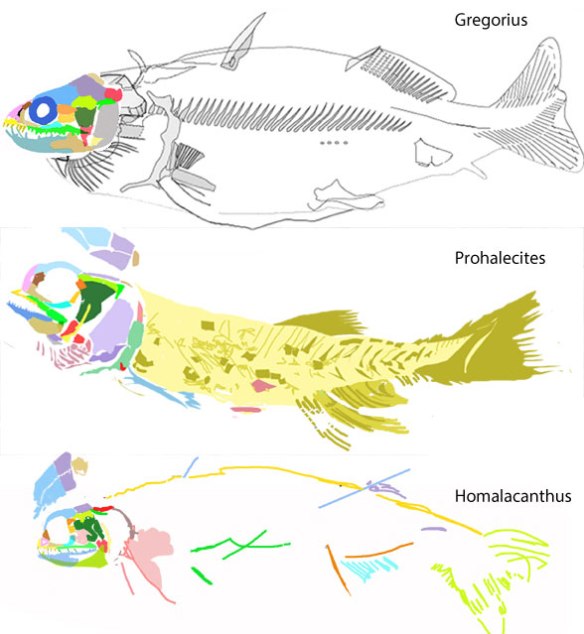
The origin and evolution of spines on fins
Academic fish workers think spiny fins on spiny sharks (= acanthodians, Fig. 2) have no clear ancestors and no clear descendants. The LRT (Figs. 3,4) recovers a long set of spiny shark ancestors (like (Oxynotus, Fig. 1) and descendants (like like lobe fins and vertebrates).

The origin and evolution of the anal fin
The absence of the anal fin on Oxynotus brings up the subject of anal fin disappearance in vertebrates. In LRT (Fig. 4), the anal fin appears early (Fig. 4 lavender) and then disappears 13x (Fig. 4 amber), ultimately lost forever in Panderichthys + tetrapods.
Traditionally (= in textbooks)
Oxynotus (Fig. 1) is considered a member of the Squaliformes (dogfish sharks). The
last common ancestor in the LRT (subset Fig. 4) is the extant dogfish, Squalus (Fig. 5).
Kriwet and Klug 2009 wrote,
“Dogfish sharks (the Squaliformes) are a highly diverse group of neoselachian sharks occurring in coastal and oceanic, cool temperate, and deep tropical waters worldwide.”
There’s that phrase, “highly diverse” again. This time, however, if Squaliformes are indeed monophyletic, Kriwet and Klug grossly underestimate the diversity of this clade, which includes the authors themsevles!
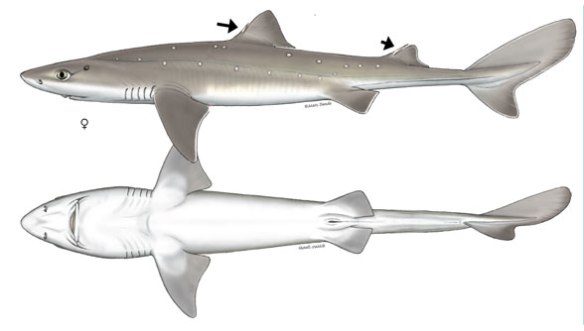
LRT taxonomy
In the LRT (Fig. 2) Squalus (Fig. 5) is the last common ancestor of a small clade that includes chimaera (ratfish).
In the LRT (Fig. 2) Squalus is close to the last common ancestor of a much larger clade that includes ratfish, all more derived sharks, all bony fish (including tetrapods).
In the LRT (Fig. 2) Oxynotus and other sharks that look like Squalus are currently separated from Squalus by traditional non-squaliform taxa, like Isurus, a traditional lamniform alongside the CMNH 9280 specimen from the Late Devonian.
More taxa in the LRT will probably solve this issue. Either Lamniformes arise from squaliformes or some phylogenetic definitions need to change.
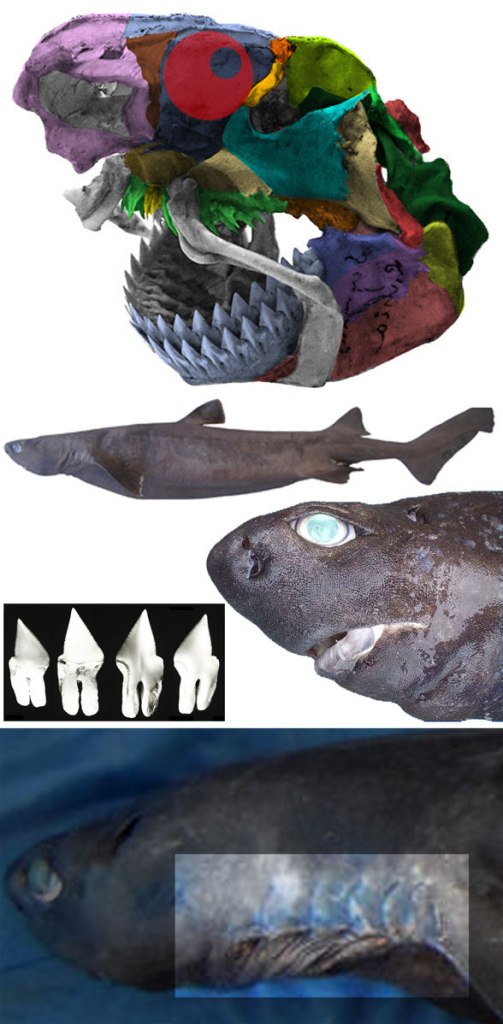
According to Kriwet and Klug 2009
the fossil record of Squaliformes consists predominantly of isolated teeth that date back to the Barremian (Early Cretaceous), ca. 125 million years ago. Full body fossils are found in Late Cretaceous strata.
In the LRT chronological bracketing hypothetically moves that record back to the Silurian.
According to Kriwet and Klug 2009
“The supertree resulting from combining published partial phylogenetic hypotheses the most inclusive estimate of squaliform interrelationships to date showing 23 out of about 35 known fossil and extant genera. The results presented here are in general agreement with most published phylogenetic hypotheses and differ only slightly from others. According to our hypothesis, Squaliformes is composed of six monophyletic groupings of family rank; Squalidae (Squalus and †Protosqualus) is separated at the deepest branching level from all other squaliforms according to this reconstruction.”
Unfortunately,
Kriwet and Klug did what most shark experts did and do: they cherry-picked only those taxa that look like Squalus. Their cladogram includes no rays, ratfish, higher sharks, bony fish and tetrapod descendants of Squalus. In the LRT (Figs. 3, 4) taxon inclusion sheds new light on hypothetical interrelationships.
Let your software tell you which taxa to include and exclude.
Don’t cherry-pick taxa based on obvious traits. Monophyly is a powerful concept that needs to be utilized at all nodes.
References
Kriwet J and Klug 2009. Fossil record and origin of squaliform sharks. (Chondrichthyes, Neoselachii. Pp. xx –xx. (Gallucci, McFarlane and Bargmann eds.) In Biology and Management of dogfish sharks. Chapter: Fossil record and origin of squaliform sharks (Chondrichthyes, Neoselachii). American Fisheries Society, Maryland.
Linnaeus C 1758. Systema naturæ per regna tria naturæ, secundum classes, ordines, genera, species, cum characteribus, differentiis, synonymis, locis. Tomus I. Editio decima, reformata
wiki/Angular_roughshark – Oxynotus
wiki/Acanthodii
wiki/Squaliformes

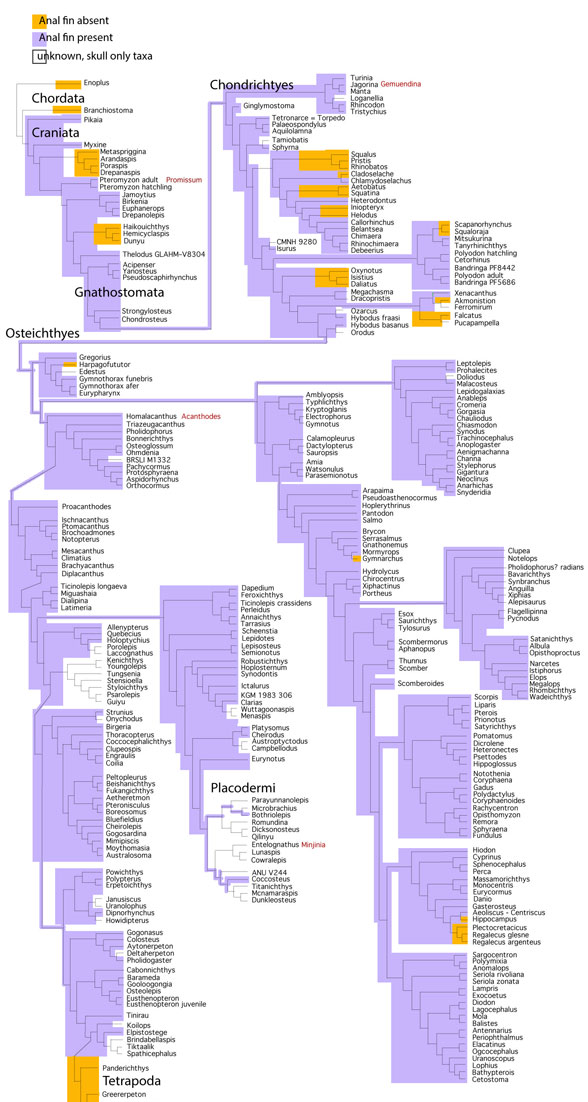
A couple of things. Oxynotus is fascinating. I was lucky enough to dissect the head of one and have the skull and jaws; the jaws are very odd and it is now known (several studies) that they feed almost exclusively on shark and skate egg cases, cutting holes in them and sucking out the contents. The structure of the mouth and teeth is almost identical to Isistius and Dalatias, and similar to other squaliformes.
Anal fins are absent in all batoids, and also in all squalean sharks more derived than the Hexanchiformes, so 2 losses there. In the living holocephalans they are very small in most or absent- the anal fin was used to separate the genera Chimaera and Hydrolagus even though we now know the species of the 2 genera are mixed and the genera should probably be synonyms. In many, the anal fin is an incipient ridge and so it is arbitrary if you say it is present or not. It is likely that was the case in extinct holocephalans too, with incipient fins not being seen in the fossils. As far as I am aware, no-one has studies chimaeras anal fins to see if they are homologous with those of other chondrichthyes and not an elongate and separate lobe of the anal fin (which they look like in Callorhynchus).
Intriguing feeding strategy. If better data exists for the skull of Oxynotus, please cite or send! Present data is a bit nebulous.
It is in my office and I am at home- I will be there in a couple of weeks. There are several recent papers on its feeding. I also heard of one in a Spanish aquarium that refused any food, but seemed fine, but at the same time there were none of the usual skate eggs all over the tank- the found out the Oxynotus followed the skates and snaffled their eggs.